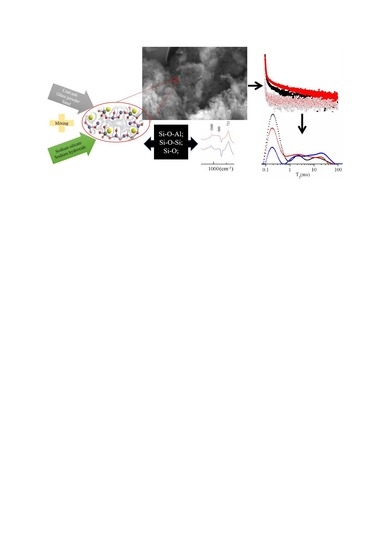Revealing the Influence of Microparticles on Geopolymers’ Synthesis and Porosity
Abstract
1. Introduction
2. Materials and Methods
2.1. Materials
2.2. Sample Preparation
- Coal-ash particles lower than 80 µm;
- Glass powder particles lower than 10 µm;
- Sand particles lower than 4 mm;
- Raw material relative humidity close to 0%;
- Raw material percentage of silicon and aluminum oxides higher than 75%;
- Curing temperature 70 °C;
- Curing time of 8, 16 or 24 h;
- Solid to liquid ratio of 1; and
- Sodium silicate to 10 M sodium hydroxide ratio of 1.5.
2.3. Methods
2.3.1. NMR Relaxometry
2.3.2. Fourier Transform Infrared Spectroscopy
3. Results and Discussion
Raw Materials Characterization
4. Conclusions
Author Contributions
Funding
Conflicts of Interest
References
- Lemougna, P.N.; Wang, K.; Tang, Q.; Melo, U.C.; Cui, X. Recent developments on inorganic polymers synthesis and applications. Ceram. Int. 2016, 42, 15142–15159. [Google Scholar] [CrossRef]
- Nergis, D.D.B.; Abdullah, M.M.A.B.; Vizureanu, P.; Tahir, M.F.M. Geopolymers and Their Uses: Review. IOP Conf. Ser. Mater. Sci. Eng. 2018, 374, 12019. [Google Scholar] [CrossRef]
- Nergis, D.D.B.; Vizureanu, P.; Corbu, O. Synthesis and characteristics of local fly ash based geopolymers mixed with natural aggregates. Revista de Chimie 2019, 70, 1262–1267. [Google Scholar] [CrossRef]
- Álvarez-Ayuso, E.; Querol, X.; Plana, F.; Alastuey, A.; Moreno, N.; Izquierdo, M.; Font, O.; Moreno, T.; Díez, S.; Vázquez, E.; et al. Environmental, physical and structural characterisation of geopolymer matrixes synthesised from coal (co-)combustion fly ashes. J. Hazard. Mater. 2008, 154, 175–183. [Google Scholar] [CrossRef] [PubMed]
- Davidovits, J. 30 years of successes and failures in geopolymer applications. Market trends and potential breakthroughs. In Proceedings of the Geopolymer 2002 Conference, Melbourne, Australia, 28–29 October 2002. [Google Scholar]
- Davidovits, J. Geopolymers and geopolymeric materials. J. Therm. Anal. Calorim. 1989, 35, 429–441. [Google Scholar] [CrossRef]
- Zhang, H.Y.; Kodur, V.; Qi, S.L.; Cao, L.; Wu, B. Development of metakaolin–fly ash based geopolymers for fire resistance applications. Constr. Build. Mater. 2014, 55, 38–45. [Google Scholar] [CrossRef]
- Belviso, C. State-of-the-art applications of fly ash from coal and biomass: A focus on zeolite synthesis processes and issues. Prog. Energy Combust. Sci. 2018, 65, 109–135. [Google Scholar] [CrossRef]
- Zaidi, S.F.A.; Haq, E.U.; Nur, K.; Ejaz, N.; Anis-Ur-Rehman, M.; Zubair, M.; Naveed, M. Synthesis & characterization of natural soil based inorganic polymer foam for thermal insulations. Constr. Build. Mater. 2017, 157, 994–1000. [Google Scholar]
- Norkhairunnisa, M.; Fariz, M.M. Geopolymer: A Review on Physical Properties of Inorganic Aluminosilicate Coating Materials. Mater. Sci. Forum 2015, 803, 367–373. [Google Scholar] [CrossRef]
- Yoldi, M.; Fuentes-Ordoñez, E.; Korili, S.; Gil, A. Zeolite synthesis from industrial wastes. Microporous Mesoporous Mater. 2019, 287, 183–191. [Google Scholar] [CrossRef]
- Liguori, B.; Aprea, P.; Roviello, G.; Ferone, C. Self-supporting zeolites by Geopolymer Gel Conversion (GGC). Microporous Mesoporous Mater. 2019, 286, 125–132. [Google Scholar] [CrossRef]
- Ma, H.; Qian, S.; Li, V.C. Influence of fly ash type on mechanical properties and self-healing behavior of Engineered Cementitious Composite (ECC). In Proceedings of the 9th International Conference on Fracture Mechanics of Concrete and Concrete Structures, Berkeley, CA, USA, 28 May–1 June 2016. [Google Scholar]
- Cilla, M.S.; Morelli, M.R.; Colombo, P. Effect of process parameters on the physical properties of porous geopolymers obtained by gelcasting. Ceram. Int. 2014, 40, 13585–13590. [Google Scholar] [CrossRef]
- Panias, D.; Giannopoulou, I.P.; Perraki, T. Effect of synthesis parameters on the mechanical properties of fly ash-based geopolymers. Colloids Surf. A Physicochem. Eng. Asp. 2007, 301, 246–254. [Google Scholar] [CrossRef]
- Luhar, S.; Cheng, T.-W.; Nicolaides, D.; Luhar, I.; Panias, D.; Sakkas, K. Valorisation of glass wastes for the development of geopolymer composites – Durability, thermal and microstructural properties: A review. Constr. Build. Mater. 2019, 222, 673–687. [Google Scholar] [CrossRef]
- Ahmad, R.; Abdullah, M.M.A.B.; Hussin, K.; Sandu, A.V.; Hussain, R.R.; Jaya, N.A. Fabrication of high performance geopolymer ceramic Part I—Microstructural properties. Appl. Mech. Mater. 2015, 754, 698–702. [Google Scholar] [CrossRef]
- Hureau, M.; Moissette, A.; Tzanis, L.; Daou, T. Effects of the zeolite particle size on the charge separated states. Microporous Mesoporous Mater. 2017, 254, 121–127. [Google Scholar] [CrossRef]
- Doru, D.; Nergis, B.; al Bakri Abdullah, M.M.; Vizureanu, P. The effect of fly ash/alkaline activator ratio in class f fly ash based geopolymers. Eur. J. Mater. Sci. Eng. 2017, 2, 111–119. [Google Scholar]
- Zerfu, K.; Ekaputri, J. Review on alkali-activated fly ash based geopolymer concrete. Mater. Sci. Forum 2016, 841, 162–169. [Google Scholar] [CrossRef]
- Siyal, A.A.; Azizli, K.A.M.; Man, Z.; Ullah, H. Effects of parameters on the setting time of fly ash based geopolymers using taguchi method. Procedia Eng. 2016, 148, 302–307. [Google Scholar] [CrossRef]
- Lahoti, M.; Wong, K.K.; Yang, E.-H.; Tan, K.H. Effects of Si/Al molar ratio on strength endurance and volume stability of metakaolin geopolymers subject to elevated temperature. Ceram. Int. 2018, 44, 5726–5734. [Google Scholar] [CrossRef]
- Wan, Q.; Rao, F.; Song, S.; Cholico-González, D.F.; Ortiz, N.L.; Cholico, D.F.; Lara, N.O. Combination formation in the reinforcement of metakaolin geopolymers with quartz sand. Cem. Concr. Compos. 2017, 80, 115–122. [Google Scholar] [CrossRef]
- Criado, M.; Aperador, W.; Sobrados, I. Microstructural and mechanical properties of alkali activated colombian raw materials. Materials 2016, 9, 158. [Google Scholar] [CrossRef] [PubMed]
- Bai, C.; Colombo, P. Processing, properties and applications of highly porous geopolymers: A review. Ceram. Int. 2018, 44, 16103–16118. [Google Scholar] [CrossRef]
- Pop, A.; Ardelean, I. Monitoring the size evolution of capillary pores in cement paste during the early hydration via diffusion in internal gradients. Cem. Concr. Res. 2015, 77, 76–81. [Google Scholar] [CrossRef]
- Pop, A.; Badea, C.; Ardelean, I. Monitoring the ettringite formation in cement paste using low field T 2-NMR. AIP Conf. Proc. 2013, 1565, 141–144. [Google Scholar]
- Bede, A.; Scurtu, A.-D.; Ardelean, I. NMR relaxation of molecules confined inside the cement paste pores under partially saturated conditions. Cem. Concr. Res. 2016, 89, 56–62. [Google Scholar] [CrossRef]
- Xia, M.; Shi, H.; Guo, X. Probing the structural evolution during the geopolymerization process at an early age using proton NMR spin-lattice relaxation. Mater. Lett. 2014, 136, 222–224. [Google Scholar] [CrossRef]
- Suwan, T.; Fan, M. Influence of OPC replacement and manufacturing procedures on the properties of self-cured geopolymer. Constr. Build. Mater. 2014, 73, 551–561. [Google Scholar] [CrossRef]
- Nergis, D.D.B.; Abdullah, M.M.A.B.; Sandu, A.V.; Vizureanu, P. XRD and TG-DTA study of new alkali activated materials based on fly ash with sand and glass powder. Materials 2020, 13, 343. [Google Scholar] [CrossRef]
- Nergis, D.D.B.; Vizureanu, P.; Andrusca, L.; Achitei, D.C. Performance of local fly ash geopolymers under different types of acids. IOP Conf. Ser. Mater. Sci. Eng. 2019, 572, 12026. [Google Scholar] [CrossRef]
- Provencher, S.W. CONTIN: A general purpose constrained regularization program for inverting noisy linear algebraic and integral equations. Comput. Phys. Commun. 1982, 27, 229–242. [Google Scholar] [CrossRef]
- Shi, C.; Wu, Y.; Riefler, C.; Wang, H. Characteristics and pozzolanic reactivity of glass powders. Cem. Concr. Res. 2005, 35, 987–993. [Google Scholar] [CrossRef]
- Corbu, O.; Ioani, A.M.; Abdullah, M.M.A.B.; Meita, V.; Szilagyi, H.; Sandu, A.V. The pozzoolanic activity level of powder waste glass in comparisons with other powders. Key Eng. Mater. 2015, 660, 237–243. [Google Scholar] [CrossRef]
- Lahoti, M.; Tan, K.H.; Yang, E.-H. A critical review of geopolymer properties for structural fire-resistance applications. Constr. Build. Mater. 2019, 221, 514–526. [Google Scholar] [CrossRef]
- Ma, Y.; Hu, J.; Ye, G. The pore structure and permeability of alkali activated fly ash. Fuel 2013, 104, 771–780. [Google Scholar] [CrossRef]
- Andoni, A.; Delilaj, E.; Ylli, F.; Taraj, K.; Korpa, A.; Xhaxhiu, K.; Çomo, A. FTIR spectroscopic investigation of alkali-activated fly ash: Atest study. Zastita Materijala 2018, 59, 539–542. [Google Scholar] [CrossRef]
- Khan, S.A.; Uddin, I.; Moeez, S.; Ahmad, A. Fungus-mediated preferential bioleaching of waste material such as fly—Ash as a means of producing extracellular, protein capped, fluorescent and water soluble silica nanoparticles. PLoS ONE 2014, 9, e107597. [Google Scholar] [CrossRef]
- Williams, R.; Van Riessen, A. Determination of the reactive component of fly ashes for geopolymer production using XRF and XRD. Fuel 2010, 89, 3683–3692. [Google Scholar] [CrossRef]
- Criado, M.; Fernández-Jiménez, A.; Palomo, A. Alkali activation of fly ash: Effect of the SiO2/Na2O ratio. Part I: FTIR study. Microporous Mesoporous Mater. 2007, 106, 180–191. [Google Scholar] [CrossRef]
- Torres-Carrasco, M.; Palomo, J.G.; Puertas, F. Sodium silicate solutions from dissolution of glasswastes. Statistical analysis. Materiales de Construcción 2014, 64, e014. [Google Scholar] [CrossRef]
- Azimi, E.A.; Abdullah, M.M.A.B.; Vizureanu, P.; Salleh, M.A.A.M.; Sandu, A.V.; Chaiprapa, J.; Yoriya, S.; Hussin, K.; Aziz, I.H. Strength development and elemental distribution of dolomite/fly ash geopolymer composite under elevated temperature. Materials 2020, 13, 1015. [Google Scholar] [CrossRef] [PubMed]
- Madavarapu, S.B.; Neithalath, N.; Rajan, S.; Marzke, R. FTIR Analysis of Alkali Activated Slag and Fly Ash Using Deconvolution Techniques. Master’s Thesis, Arizona State University, Tempe, AZ, USA, August 2014. [Google Scholar]
- Zhang, S. Waste Glass as Partial Binder Precursor and Fine Aggregate Replacement in Alkali Activated Slag/Fly ash System. Master’s Thesis, Delft University of Technology, Delft, The Netherlands, December 2014. [Google Scholar]
- Anbalagan, G.; Prabakaran, A.R.; Gunasekaran, S. Spectroscopic characterization of indian standard sand. J. Appl. Spectrosc. 2010, 77, 86–94. [Google Scholar] [CrossRef]



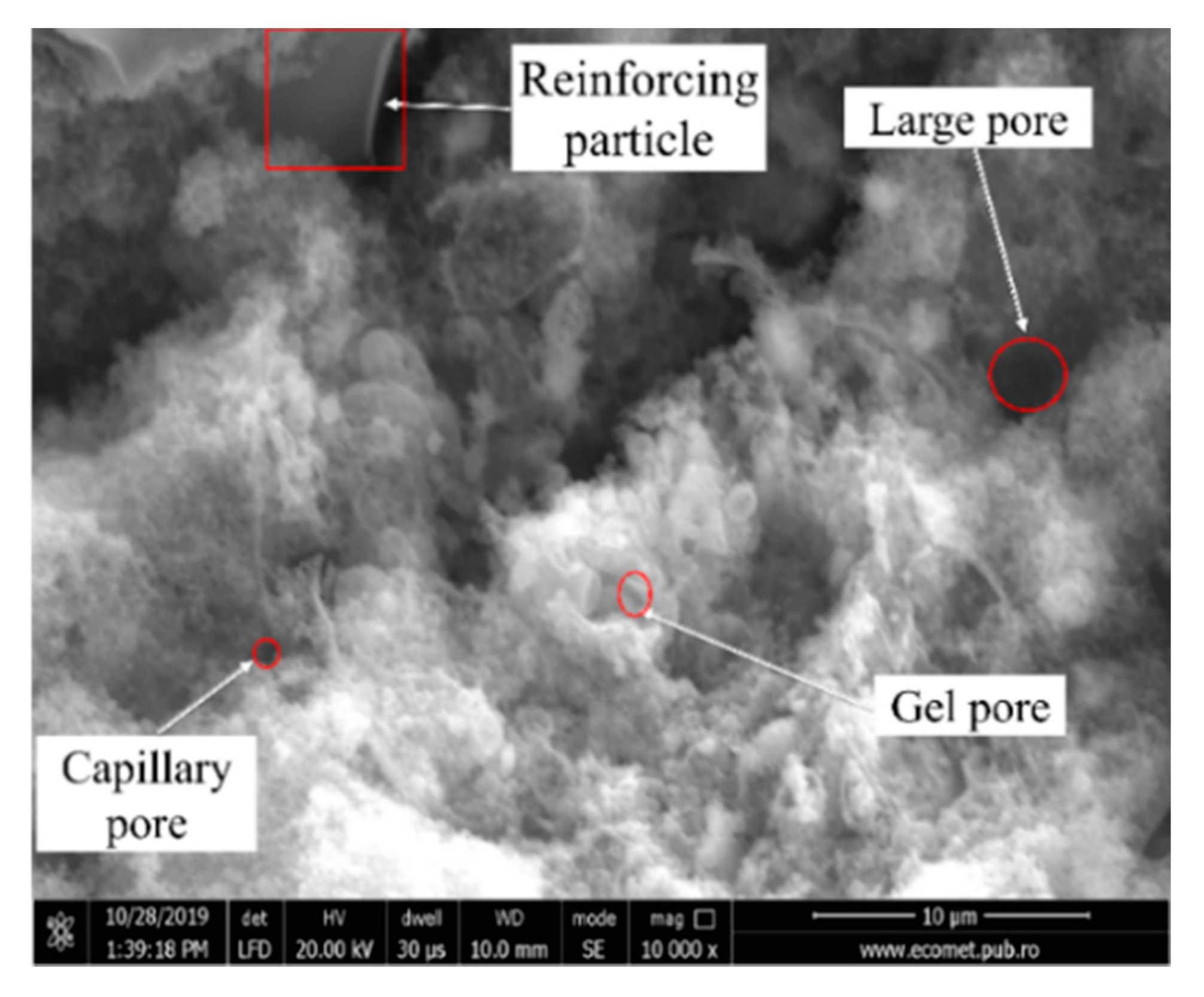

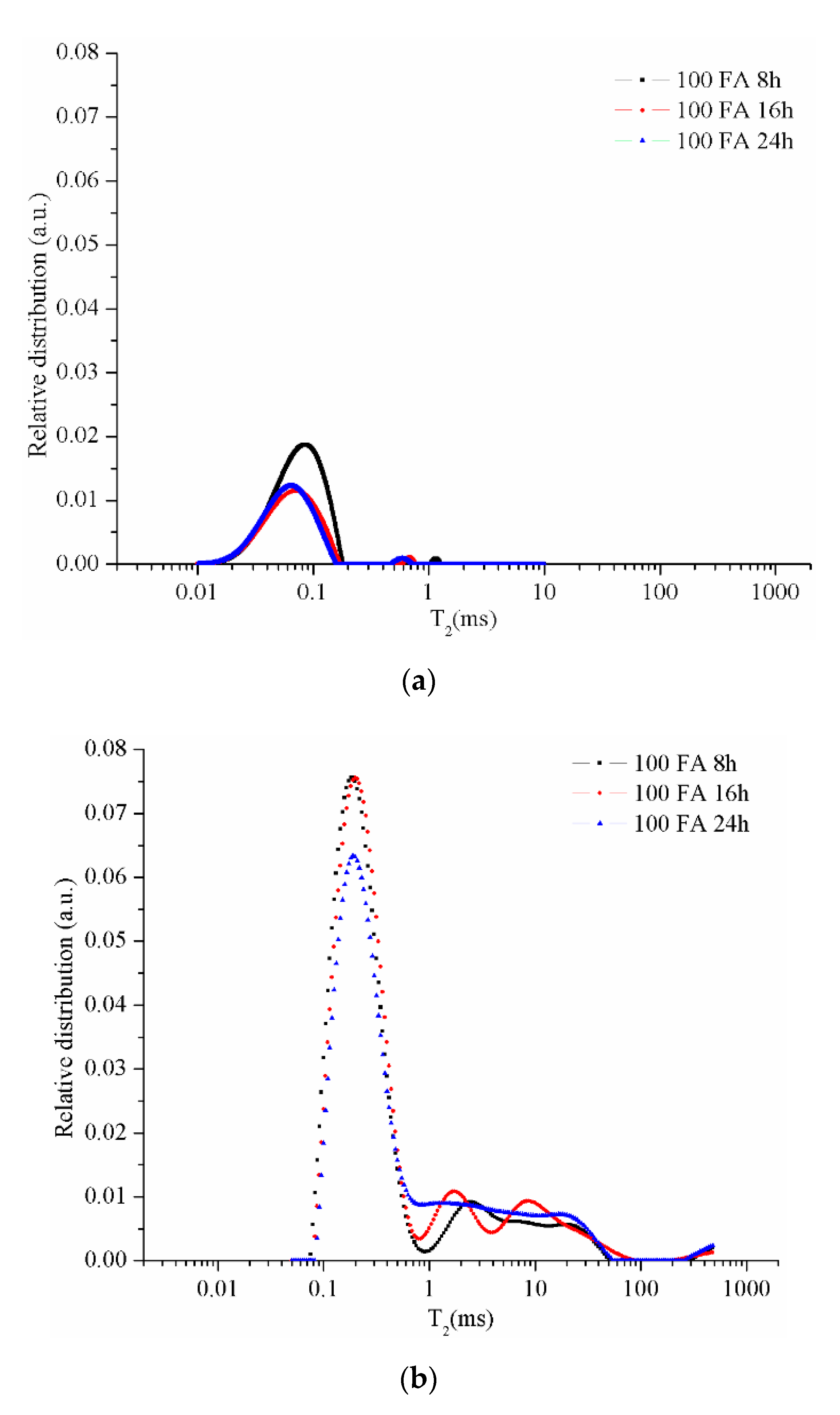
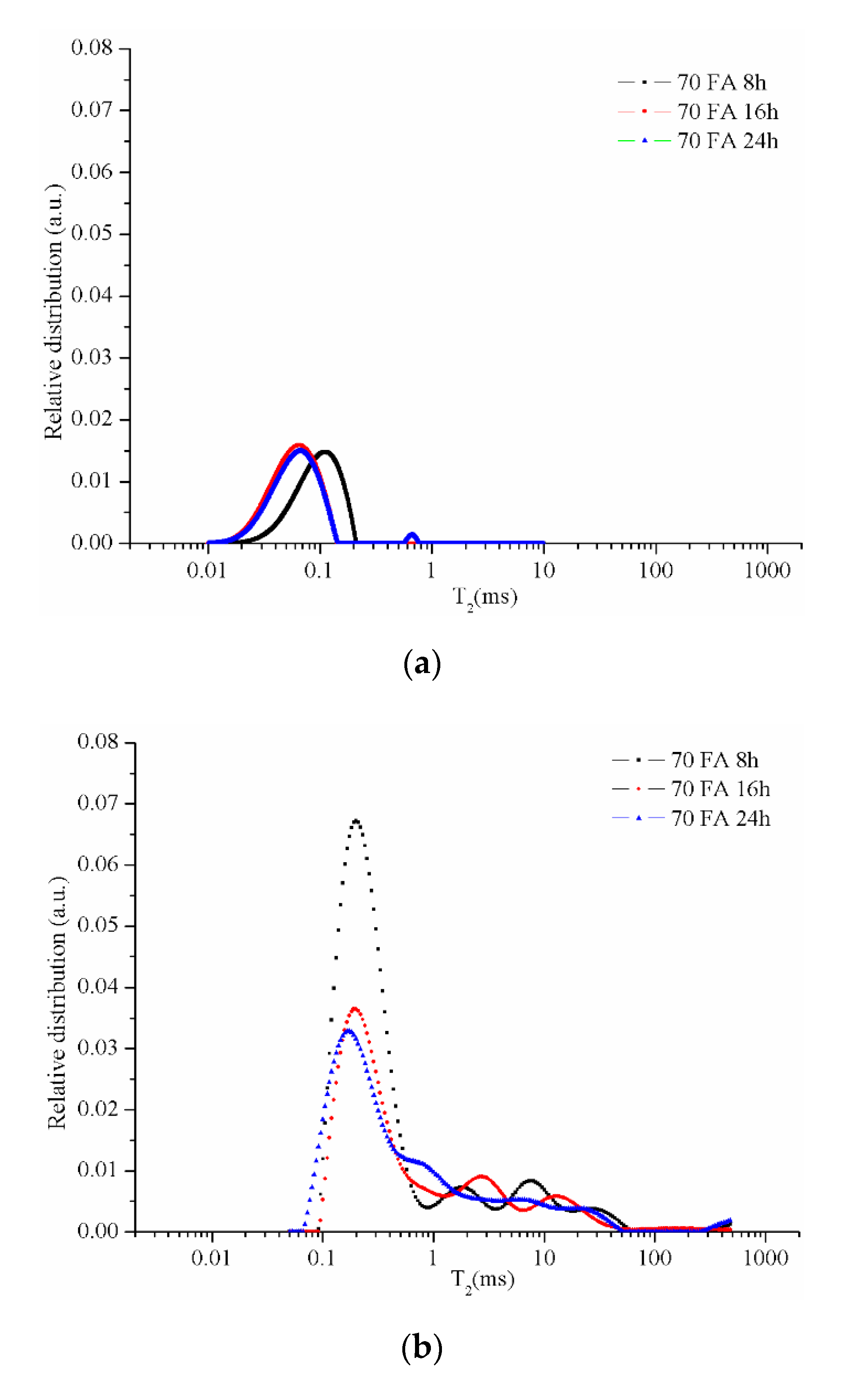
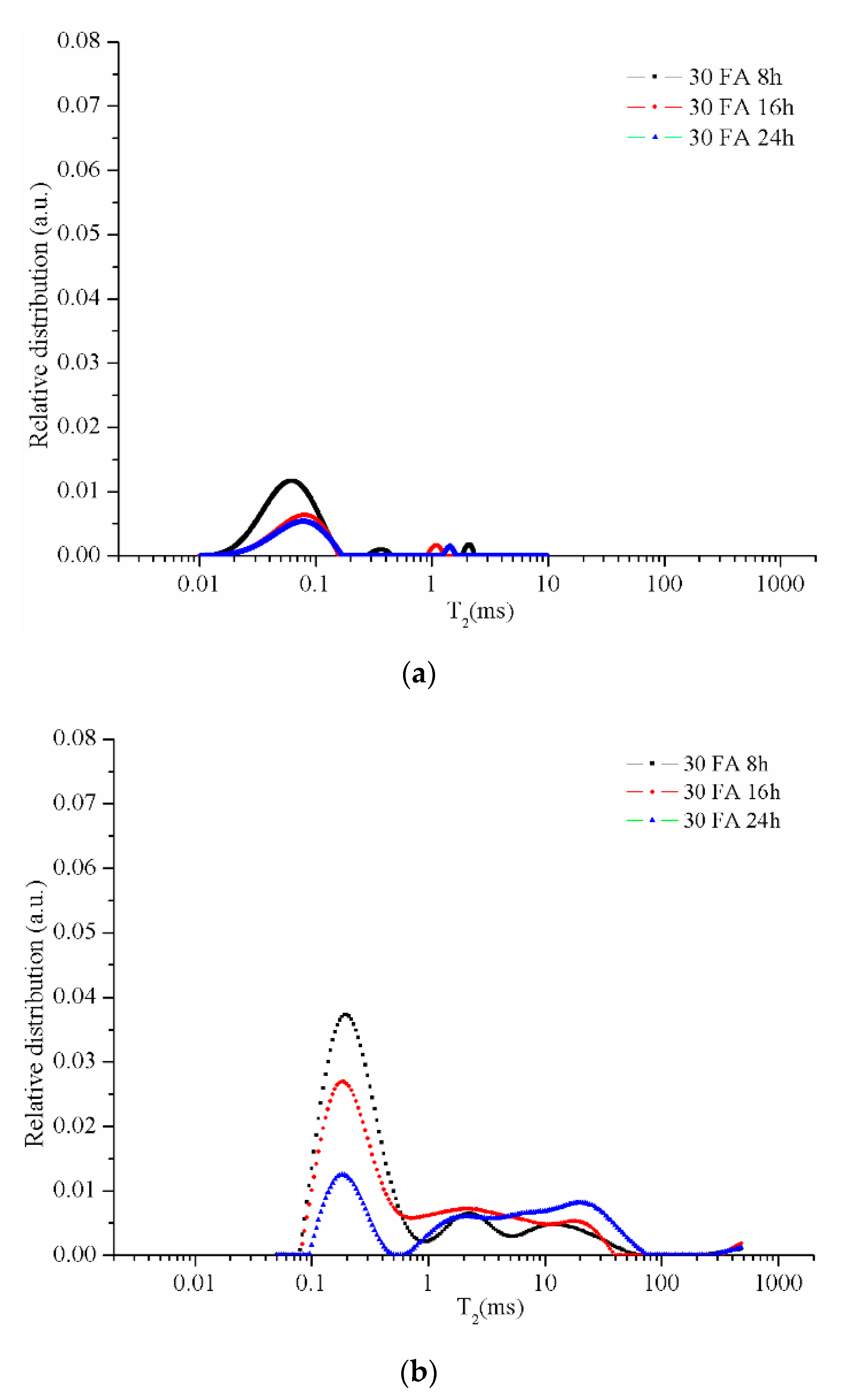
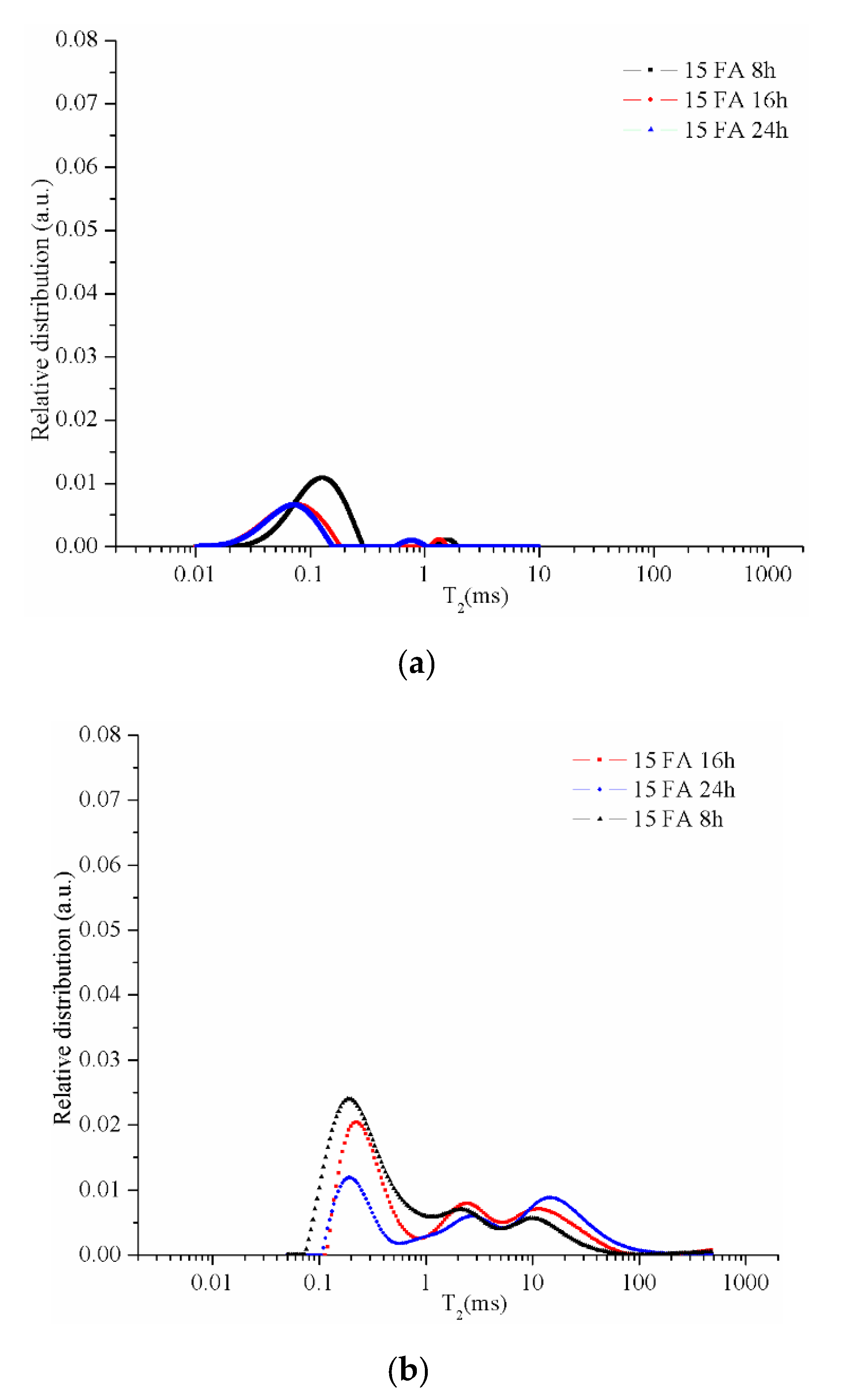

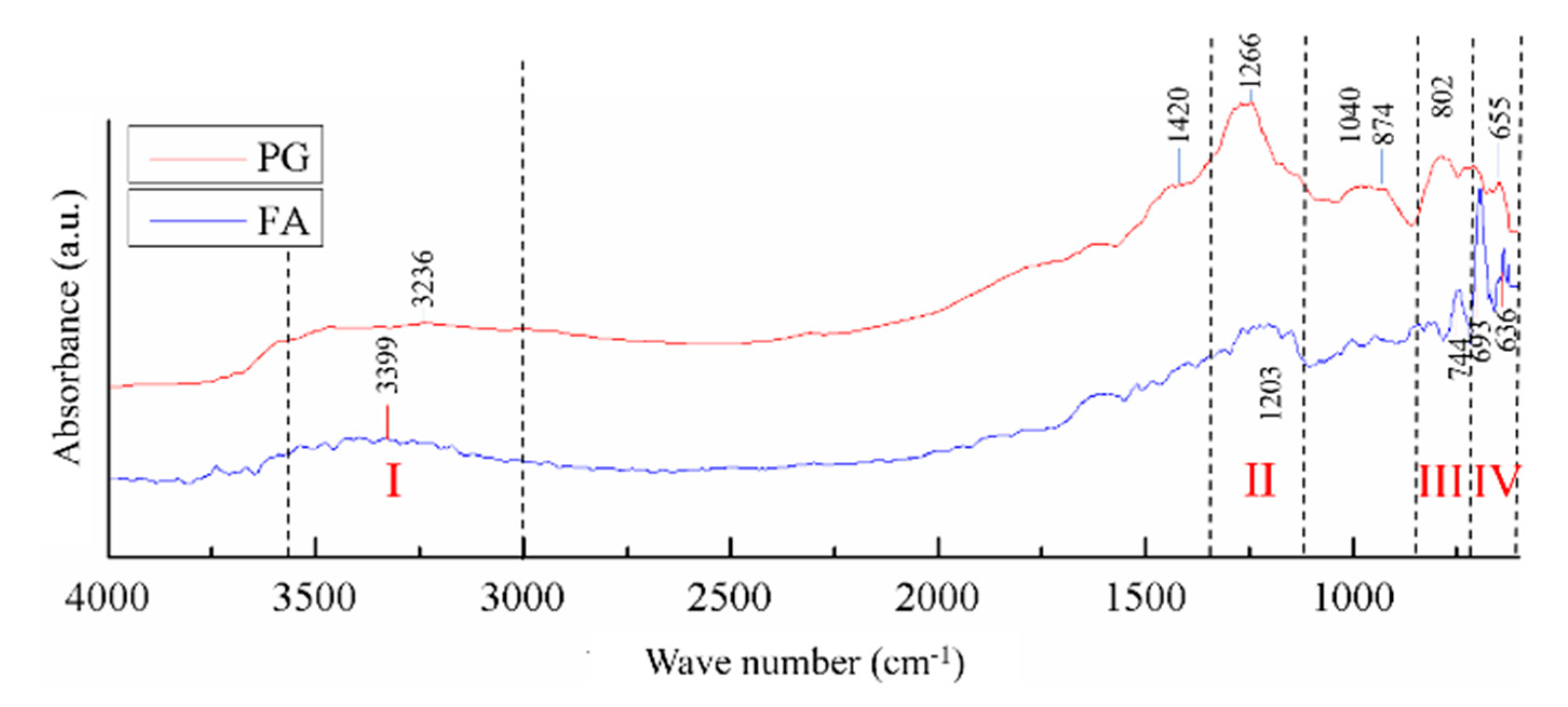

| Oxide | SiO2 | Al2O3 | FexOy | CaO | K2O | MgO | TiO2 | Na2O | P2O5 | Oth.1 |
|---|---|---|---|---|---|---|---|---|---|---|
| %, weight | 47.80 | 28.60 | 10.20 | 6.40 | 2.40 | 2.00 | 1.30 | 0.60 | 0.40 | 0.30 |
| Oxide | SiO2 | Al2O3 | FexOy | CaO | Na2O | MgO | Oth.1 |
|---|---|---|---|---|---|---|---|
| %, weight | 71.69 | 1.81 | 0.93 | 13.2 | 9.89 | 2.40 | 0.08 |
| Sample | Drying Time | Peak 1 | Peak 2 | Peak 3 | ||||||
|---|---|---|---|---|---|---|---|---|---|---|
| X1 (ms) | X2 (ms) | Area (a.u.) | X1 (ms) | X2 (ms) | Area (a.u.) | X1 (ms) | X2 (ms) | Area (a.u.) | ||
| 15FA | 8 h | 0.07 | 1.07 | 0.01 | 1.07 | 5.17 | 0.02 | 5.17 | 86.81 | 0.11 |
| 30FA | 8 h | 0.07 | 0.91 | 0.01 | 0.91 | 5.24 | 0.01 | 5.24 | 61.16 | 0.12 |
| 70FA | 8 h | 0.09 | 0.89 | 0.01 | 0.89 | 3.71 | 0.01 | 3.71 | 63.17 | 0.18 |
| 100FA | 8 h | 0.07 | 0.91 | 0.02 | 0.91 | 5.63 | 0.03 | 5.62 | 50.40 | 0.17 |
| 15FA | 16 h | 0.11 | 0.88 | 0.01 | 0.88 | 5.08 | 0.02 | 5.08 | 76.65 | 0.20 |
| 30FA | 16 h | 0.08 | 0.69 | 0.01 | 0.69 | 9.91 | 0.05 | 9.91 | 40.40 | 0.10 |
| 70FA | 16 h | 0.09 | 1.25 | 0.01 | 1.25 | 6.42 | 0.03 | 6.42 | 60.60 | 0.12 |
| 100FA | 16 h | 0.07 | 0.80 | 0.02 | 0.80 | 3.83 | 0.02 | 3.83 | 91.74 | 0.24 |
| 15FA | 24 h | 0.10 | 0.53 | 0.01 | 0.53 | 4.94 | 0.02 | 4.94 | 150.2 | 0.35 |
| 30FA | 24 h | 0.09 | 0.56 | 0.01 | 0.56 | 5.57 | 0.02 | 5.57 | 76.65 | 0.30 |
| 70FA | 24 h | 0.06 | 1.65 | 0.01 | 1.65 | 12.65 | 0.05 | 12.65 | 53.02 | 0.09 |
| 100FA | 24 h | 0.08 | 0.82 | 0.01 | 0.82 | 10.37 | 0.07 | 40.37 | 55.78 | 0.18 |
© 2020 by the authors. Licensee MDPI, Basel, Switzerland. This article is an open access article distributed under the terms and conditions of the Creative Commons Attribution (CC BY) license (http://creativecommons.org/licenses/by/4.0/).
Share and Cite
Burduhos Nergis, D.D.; Vizureanu, P.; Ardelean, I.; Sandu, A.V.; Corbu, O.C.; Matei, E. Revealing the Influence of Microparticles on Geopolymers’ Synthesis and Porosity. Materials 2020, 13, 3211. https://doi.org/10.3390/ma13143211
Burduhos Nergis DD, Vizureanu P, Ardelean I, Sandu AV, Corbu OC, Matei E. Revealing the Influence of Microparticles on Geopolymers’ Synthesis and Porosity. Materials. 2020; 13(14):3211. https://doi.org/10.3390/ma13143211
Chicago/Turabian StyleBurduhos Nergis, Dumitru Doru, Petrica Vizureanu, Ioan Ardelean, Andrei Victor Sandu, Ofelia Cornelia Corbu, and Ecaterina Matei. 2020. "Revealing the Influence of Microparticles on Geopolymers’ Synthesis and Porosity" Materials 13, no. 14: 3211. https://doi.org/10.3390/ma13143211
APA StyleBurduhos Nergis, D. D., Vizureanu, P., Ardelean, I., Sandu, A. V., Corbu, O. C., & Matei, E. (2020). Revealing the Influence of Microparticles on Geopolymers’ Synthesis and Porosity. Materials, 13(14), 3211. https://doi.org/10.3390/ma13143211









